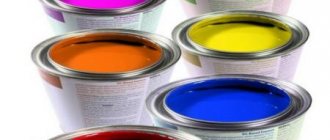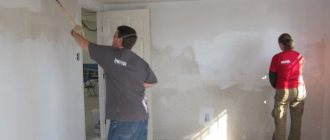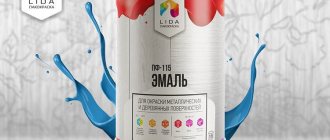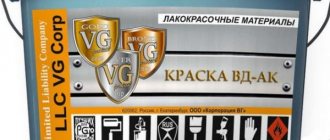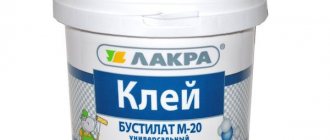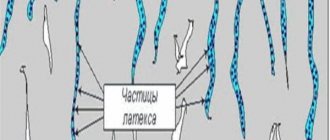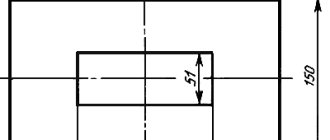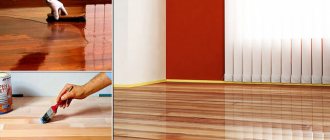1.TECHNICAL REQUIREMENTS
1.1. Primer GF-021 must be manufactured in accordance with the requirements of this standard according to the recipe and technological regulations approved in the prescribed manner.
1.2. The GF-021 primer is applied to the surface by pneumatic and airless spraying, spraying in an electric field, jet pouring, dipping, or brush.
1.3. Before use, the primer is diluted to working viscosity with solvent (GOST 10214 or GOST 1928), xylene (GOST 9949 or GOST 9410), or a mixture of one of these solvents with white spirit (nefras-SCh-155/200) according to GOST 3134 in a ratio of mass 1:1.
To paint products by spraying in an electric field, the primer is diluted with RE-4V thinner (GOST 18187).
(Changed edition, Amendment No. 1).
1.4. The primer must comply with the requirements and standards specified in table. 1.
Table 1
| Indicator name | Norm | Test method |
| 1. Primer film color | Red-brown, shade not standardized | According to clause 4.3 |
| 3. Appearance of the film | After drying, the film should be smooth, uniform, matte or semi-gloss | According to clause 4.3 |
| 3. Conditional viscosity at (20.0±0.5)°С according to the VZ-4 viscometer, s, not less | 45 | According to GOST 8420 |
| 4. Degree of primer dilution with solvent, %, no more | 20 | According to clause 4.4 |
| 5. Mass fraction of non-volatile substances, % | 54-60 | According to GOST 17537, section. 1 and clause 4.5 of this standard |
| 6. Degree of grinding, microns, no more | 40 | According to GOST 6589 |
| 7. Drying time to degree 3, no more at (105±5)°C, min | 35 | According to GOST 19007 |
| (20±2) °С, h | 24 | |
| 8. Film hardness according to the pendulum device M-3, conventional units, not less | 0,35 | According to GOST 5233 |
| 9. Film elasticity when bending, mm, no more | 1 | According to GOST 6806 |
| 10. Film strength upon impact on a U-1 type device, cm, not less | 50 | According to GOST 4765 |
| 11. Film adhesion, points, no more | 1 | According to GOST 15140, section. 2 |
| 12. Film resistance to static action of 3% sodium chloride solution, h, not less | 24 | According to GOST 9.403, section. 2 and clause 4.7 of this standard |
| 13. The ability of the film to be sanded | When sanding, the film should form a smooth surface and not stain the sandpaper. | According to clause 4.8 |
| 14. Film resistance to nitro enamel | There should be no peeling, wrinkling, or cracking of the nitro enamel film applied to the primer | According to clause 4.9 |
| 15. Film resistance to static effects of mineral oil at (20±2)°C, h, not less | 48 | According to GOST 9.403, section. 2 and clause 4.10 of this standard |
| 16. Delamination, ml, no more | 5 | According to clause 4.11 |
Note. The formation of an easily stirred sediment during storage is allowed, as well as an increase in the degree of dilution of the primer, if after thorough stirring and dilution the primer meets the requirements of this standard.
(Changed edition, Amendment No. 1, 2).
Application
The use of primer is traditional.
Work progress
After the primer has been thoroughly mixed:
- prepare the work surface, which must be leveled and dried;
- all corrosion is removed from the metal ; here, the use of iron brushes is often unavoidable;
- if the surface is wooden, it is sanded;
- the surface must be checked for the presence of fat , it should not be of any kind - that is why it is not recommended to use a primer on undried coniferous wood, the oil in these species is their internal property, which cannot be eliminated;
- Please note that the percentage of solvent and initial mass during its preparation should not exceed 25% ;
The composition of the GF-021 primer is such that it forces you to pay utmost attention to personal protective equipment and no worse than in the photo, since everything has to be done with your own hands
- when the surface is ready, you can use a brush or spray gun to apply the primer, but with a hole diameter of at least 4 mm .
Warnings
The presented material refers to flammable and toxic substances, therefore:
- all work must be carried out strictly observing the rules of personal protection;
- If the primer gets on the skin, it must be promptly removed and the affected area treated;
- Do not allow the primer to get into your eyes or respiratory tract under any circumstances;
- Primer shelf life is no more than 6 months:
- taking into account that the consumption rate of GF-021 primer per 1 m2 does not exceed 150 g in any case;
- it is supplied in containers of 25 kg;
- it turns out that the capacity is enough for 170 square meters, that is, an area of 17 by 10 meters (this almost exactly corresponds to the size of a volleyball court - 18 by 9).
Red-brown primer GF-021 is truly a miracle
SAFETY REQUIREMENTS
2.1. Primer GF-021 is a flammable and toxic material, which is due to the properties of the solvents included in the primer (Table 2).
Solvent vapors included in the primer have an irritating effect on the mucous membranes of the eyes, respiratory tract and skin.
table 2
| Component name | Maximum permissible concentration in the air of the working area of industrial premises, mg/m3, | Temperature, °C | Concentration limits of ignition,% (by volume) | Hazard Class | |
| flashes | spontaneous combustion | ||||
| Xylene | 50 | Not lower than 24 | Not higher than 450 | 1,0-6,0 | 3 |
| Solvent | 50 | 22-36 | 464-535 | 1,02 | 4 |
| White spirit (nefras-SCH-155/200) | 100 | 33 | 270 | 1,4-6,0 | 4 |
(Changed edition, Amendment No. 1).
2.2. During production, use, and testing of the primer, fire safety and industrial sanitation requirements in accordance with GOST 12.3.005 must be observed.
2.3. All work related to the manufacture, use and testing of the primer must be carried out in workshops equipped with supply and exhaust ventilation and fire safety equipment in accordance with GOST 12.3.005.
2.4. Precautionary measures: sealing production equipment, providing workers with personal protective equipment that meets the requirements of GOST 12.4.011.
2.5. Coating with a primer after drying does not have a harmful effect on the human body.
2.6. Monitoring the state of the air environment - in accordance with GOST 12.1.007 and GOST 17.2.3.02.
(Introduced additionally, Amendment No. 1).
Primer GF-021
Application instructions
The primer is a suspension of pigments and fillers in an alkyd varnish with the addition of solvents, drier and stabilizing substances
General provisions
The technological instruction regulates the technology of applying the one-component primer GF-021 for priming metal surfaces under coatings with various enamels. During the work process, it is possible to adjust the instructions in agreement with the developer of the document.
Surface preparation
The surface of the product should not have burrs, sharp edges (with a radius of less than 2 mm), welding spatter, undercuts from welding, cutting marks, or flux residues.
Degreasing before cleaning
Degrease the surface with: toluene, xylene, ortho-xylene, acetone, R-4, R-5, 646. The degree of degreasing is determined according to GOST 9.402 and must correspond to the first degree (no oil stain on filter paper when tested by the drop method).
The use of white spirit, solvent, and gasoline is prohibited!
Surface cleaning
The surface is cleaned from oxides to degree 2 according to GOST 9.402-2004 (Table 9) or degree Sa 2½ according to ISO 8501-1:2007, i.e. When viewed with the naked eye, scale, rust, burnt marks, molding sand residues and other non-metallic layers should not be detected.
Surface roughness
The roughness of the cleaned surface should be characterized as “fine”, “medium” in accordance with ISO 8503-1. If the roughness is exceeded, an additional layer of material must be applied.
Dust removal
After cleaning, the surface must be dusted with an industrial vacuum cleaner or compressed air free of oil and moisture. Control of the degree of surface dust removal is carried out in accordance with ISO 8502-3. The degree of dust removal should be no worse than the second.
Degreasing after cleaning
If there is oil contamination on the prepared surface, the surface of the product is degreased again with toluene, xylene, ortho-xylene or acetone, R-4, R-5, 646. The surface is degreased using spraying methods immediately before painting. According to the conclusion of the work manager, degreasing may not be performed.
Negative temperature
At subzero temperatures, degreasing after surface preparation must be done with acetone or R-4, R-5.
It is prohibited
use of white spirit, solvent, gasoline!
The time gap between surface preparation and primer application is:
- 6 hours outdoors;
- 24 hours when working indoors.
Prohibited
painting on wet surfaces, ice, snow!
Operating temperature
From minus 45 °C to +60 °C.
Finishing layer
Primer coating GF-021 requires mandatory coating with paints and varnishes:
- polysiloxane paints and varnishes of the Armokot® brand TU 2312-009-23354769-2008;
- organosilicate compositions TU 84-725-78;
- enamels: PF, EF, EP, FL, HV, HS, NTs, KO.
The time for overcoating the primer layer is no more than 24 hours.
Primer preparation
Before use, the primer is mixed in the manufacturer’s container with a pneumatic or electric mixer for at least 5 minutes until the sediment completely disappears and is uniform throughout the entire volume, after which it is kept for about 10 minutes until the bubbles disappear. To obtain a high-quality coating, the temperature of the primer during application should be close to the surface temperature of the product being painted.
Dilution
At positive ambient temperatures, no dilution of the primer is required. If necessary, a solvent (toluene, xylene, ortho-xylene) is added gradually in small portions (0.5% by weight of the primer, followed by stirring) until a positive result is obtained during application.
Negative temperature
Due to the increase in viscosity at negative temperatures, it is recommended to dilute the primer with toluene until a positive result is obtained during application.
Dilution should be carried out gradually, in small portions (based on the weight of the primer):
- at temperatures from 0 °C to minus 10 °C – 1-2%;
The total amount of solvent should not exceed 10%.
Prohibited
use of other thinners!
During breaks in work, the primer should be stored in a tightly closed container; before starting work, it must be mixed with a pneumatic or electric mixer.
Applying primer
Climatic conditions
Ambient temperature:
- spraying methods from minus 10 °C to +35 °C;
- brush, roller from minus 10 °C to +25 °C.
Relative air humidity no more than 80%.
Prohibited
paint during rainfall.
Prohibited
carry out painting by spraying methods at wind speeds of more than 10 m/sec.
The temperature of the surface to be painted should be 3 °C above the dew point.
Airless spray
When airless spraying (AAS), the following must be observed:
- distance from the spray gun nozzle to the surface to be painted – 300-500 mm;
- working pressure of the material 80-150 bar;
- Airless Spray Nozzle Diameter inch (mm): 0.013 (0.33); 0.015 (0.38);
- The spray angle is selected depending on the shape of the surface to be painted.
Recommended spray angle 20°, 30°, 40°.
Manual application
When applied manually, depending on the area of the structure to be painted and the configuration, rollers (lint-free, preferably velor) and brushes made of natural fibers of various sizes and shapes are used.
Stripe dyeing
If there are welds, end edges, or hard-to-reach places on the surface, it is necessary to apply a primer in the form of a “strip layer” with a brush before painting the entire surface.
Important!
At the moment of application, an even “wet” film should form on the surface in diameter of the torch imprint, without gaps, smudges, or shagreen.
To avoid visible joints, painting work over large areas must be carried out in one pass and using the same batch of primer.
Coating thickness
The primer is applied in 1-2 layers. The thickness of the single-layer coating GF-021 (on a dry layer) is 15-20 microns. The thickness of the two-layer coating (on a dry layer) is 30-40 microns.
Primer consumption
The consumption of GF-021 primer with a coating thickness (dry layer) of 30 microns is 80 g/m2 (without taking into account technological losses, depending on the application method, degree of spray, equipment used, worker qualifications, surface roughness).
Negative temperature
At negative ambient temperatures, it may be necessary to apply additional layers to achieve the required thickness. Before applying the first coat of primer, apply the pre-coat with a light spray and let it sit for 1-2 minutes. Then apply a base coat of primer.
Interlayer drying
The minimum coating holding time before applying the next layer when spraying is not less than:
| Application temperature | — 10 °C | 0 °C | +20 °C |
| Time, h, no more | 12 | 8 | 4 |
When applying the primer with a roller or brush, the intercoat drying time increases by 2-3 times compared to spraying methods.
Equipment washing
Equipment should be washed with toluene, xylene, acetone, P-4, P-5, 646.
Curing modes
Coating based on primer GF-021 - natural drying (the coating cures at ambient temperature).
Complete drying
The exposure time of the coating based on the GF-021 primer until it reaches optimal properties at 20°C is 24 hours.
Turning
It is allowed to tilt structures (with soft slings) no earlier than 24 hours after applying the layer, in order to prevent scuffing of the coating.
It is not allowed to unload structures by dropping them, or to move them by dragging.
Coating repair
If the coating area is damaged down to the metal, clean it with a hand tool until any possible rust is completely removed, remove dust, degrease and paint the area (with a brush, roller) with GF-021 primer.
Primer storage
The guaranteed shelf life of the GF-021 primer is 6 months from the date of manufacture.
The primer must be stored in a closed container in a dry room, protected from direct exposure to sunlight and moisture at temperatures from minus 10 ° C to +35 ° C.
Transport the primer according to GOST 9980.5-86. Transportation time at temperatures below minus 20 °C should not exceed 30 days.
Work quality control
All materials used in anti-corrosion work must have quality certificates confirming their compliance with technical specifications.
Primer acceptance
When you receive the primer for work, you must ensure that the container is intact, it must not be damaged and be clearly marked with the following symbols:
- name of the primer;
- name and address of the manufacturer;
- batch number;
- date of manufacture;
- best before date;
- quantity.
After cleaning the surface
When accepting the prepared surface, it is necessary to control the following parameters:
- absence of fat and oil contamination;
- degree of surface cleaning;
- no dust;
- lack of moisture.
During the application of primer
Before starting application and during the application of the primer, the following parameters are controlled:
- climatic parameters;
- uniformity of composition;
- quality and quantity of primer and stripe coats applied;
- drying time for each layer;
- thickness of the dry coating layer.
During visual inspection with the naked eye, no omissions, sagging or leaks, foreign inclusions, or areas of coating delamination should be detected on the inspected coating.
| Surface roughness profile according to ISO 8503-1 | Correction value, µm |
| Thin 25-60 microns | 10 |
| Average 60-100 microns | 25 |
| Coarse 100-150 microns | 40 |
To obtain the actual thickness of the dry coating layer during measurements, you need to subtract the correction value from the thickness gauge readings.
Safety requirements
Labor protection and safety precautions are carried out in accordance with GOST 12.3.005-75 and according to the technical documents of the work manufacturer, taking into account the properties of the soil.
The toxicity and fire hazard of the primer is due to the presence of toluene, xylene and white spirit solvents in its composition.
Toluene and xylene, in terms of the degree of impact on the human body, belong to hazard class 3, white spirit, in terms of the degree of impact on the human body, belongs to hazard class 4 according to GOST 12.1.007-76, MPC in the air of the working area - 150/50/100 mg/ m³.
When applying primer outdoors, ensure that the work area is well ventilated. Workers involved in coating application must use rubber gloves and protective pastes such as “biological gloves”. To protect the respiratory system, use gas-dust respirators.
It is strictly forbidden to apply primer in enclosed spaces, pits, or wells.
Primer GF-021 is a flammable liquid due to the presence of toluene and xylene. The flash point of toluene is 4 °C, xylene is 24 °C, white spirit is 33 °C, the auto-ignition temperature of toluene is 536 °C, xylene is 494 °C, white spirit is 270 °C. In the room for storage and work with paints and varnishes and solvents, the use of open flames (including matches, lighters, etc.) is prohibited; artificial lighting must be explosion-proof; these rooms must be equipped with supply and exhaust ventilation and fire extinguishing means.
The electrical equipment used must have reliable grounding.
When mechanically processing surfaces, it is necessary to use respirators, gloves and safety glasses, and also follow the rules for the safe operation of the mechanisms and tools used.
When working with paints and varnishes, you must follow the rules for safe work with toxic and flammable materials.
Prohibited:
- in an area with a radius of 25 m from the place of work, smoke, light a fire and carry out welding work;
- store more than a day's supply of materials at the workplace, and materials at the workplace should only be stored in serviceable sealed containers.
If the material catches fire, it is necessary to use the following fire extinguishing agents: sand, felt, asbestos blanket, foam or carbon dioxide fire extinguisher, foam installations, finely sprayed water.
Note
Information on the use of Morozov Chemical Plant JSC products is based on laboratory research and practical experience in the use of this type of product.
The products of Morozov Chemical Plant JSC are intended exclusively for professional use, which implies the fact that the final consumer has a sufficient set of knowledge about its use, is familiar with the technological instructions for this type of product and complies with technical and fire safety rules when working.
In case of improper use of materials, as well as failure to comply with the requirements of the technological instructions and additional recommendations, Morozov Chemical Plant JSC is not responsible for the service life and quality of the coating.
Morozov Chemical Plant JSC reserves the right to unilaterally change technological instructions without prior notice to customers. The latest edition of the technical instructions posted on the official website www.tdmhz.ru for each material separately is valid. If necessary, you can request the latest version of the technical instructions directly from Morozov Chemical Plant JSC.
TEST METHODS
4.1. Sampling - according to GOST 9980.2.
4.2. Preparing for the test
Plates for applying primer are prepared in accordance with GOST 8832, section. 3.
Film hardness is determined on glass for photographic plates 9´12-1.2 according to TU 6-43-0205133-03-91.
The elasticity of the film during bending is determined on plates made of black tin according to the technical documentation, 20 x 150 mm in size, 0.25 - 0.28 mm thick.
The remaining indicators are determined on plates made of steel grades 08 kp and 08 ps according to GOST 16523, size 70´150 mm, thickness 0.8 - 0.9 mm.
Conditional viscosity, degree of dilution, mass fraction of non-volatile substances and degree of grinding are determined in undiluted primer.
When determining other indicators, the primer is thoroughly mixed, diluted to a viscosity of 22 - 24 s using a Tina VZ-4 viscometer with a nozzle diameter of (4.000 ± 0.015) mm at (20.0 ± 0.5) °C with solvent or xylene, filtered through a sieve with mesh No. 01-05 (GOST 6613) and applied with a paint sprayer to the prepared plates.
When determining the resistance of the film to the static effects of a 3% solution of sodium chloride and mineral oil, the primer is applied in two layers on both sides of the plate.
Drying each layer at (105 ± 5) °C for 35 minutes. When determining other indicators, the primer is applied in one layer.
Drying a single-layer film at (105 ± 5) °C - for 35 minutes.
The thickness of a single-layer dried film should be 15-20 microns, two-layer - 30-40 microns.
After drying, the plates are kept for 3 hours at (20 ± 2) °C before testing.
4.1, 4.2. (Changed edition, Amendment No. 1).
4.3. The color and appearance of the primer film is determined visually in natural diffused light.
4.4.Determination of the degree of dilution of the primer with a solvent
120 - 130 g of primer is weighed with an error of no more than 0.1 g and diluted with solvent or xylene to a viscosity of 22 - 24 s using a VZ-4 type viscometer with a nozzle diameter of (4.000 ± 0.015) mm at (20.0 ± 0.5) °C.
Dilution rate ( X
) as a percentage is calculated using the formula
,
where t -
primer mass, g;
m
1 - mass of solvent used to dilute the primer, g.
4.5. The mass fraction of non-volatile substances is determined according to GOST 17537.
A sample weighing (2.0 ± 0.2) g is placed in a drying oven and maintained at a temperature of (140 ± 2) °C. The first weighing is carried out after 1 hour, subsequent weighings are carried out every 30 minutes until the weight remains constant.
It is possible to determine the mass fraction of non-volatile substances under an infrared lamp at a temperature of (142 ± 2) °C. In case of disagreement in the assessment of this indicator, the final result is the determination in a drying cabinet.
4.4, 4.5. (Changed edition, Amendment No. 1).
4.6. (Deleted, Amendment No. 1).
4.7. Film resistance to static action of 3% sodium chloride solution
Before inspection, the samples are kept in air at (20 ± 2) °C for 1 hour, then examined with the naked eye.
4.8. Determination of the sandability of a primer film
The plate with the dried film prepared according to clause 4.2 is sanded with sandpaper with a grain size of 4 - 5 according to GOST 6456 or GOST 10054.
4.7, 4.8. (Changed edition, Amendment No. 1).
4.9.
Determination of the resistance of the film to the action of nitro enamel
On the primer film prepared according to clause 4.2, 10 minutes after drying, three layers of enamel NTs-11 (GOST 9198) or NTs-25 (GOST 5406) are applied with a paint sprayer.
Each layer of nitro enamel is dried at (20 ± 2) °C for 10 minutes.
The thickness of each enamel layer should be 20 - 25 microns.
The enamel film should not peel off, wrinkle, or crack.
4.10. Film resistance to static effects of mineral oil
After the test, the plate is kept in air at (20 ± 2) °C for 2 hours and examined with the naked eye.
(Changed edition, Amendment No. 1).
4.11. Delamination Definition
A glass graduated cylinder 2 - 100 according to GOST 1770 is filled with diluted primer to the 100 cm3 mark and left at rest at a temperature of (20 ± 2) °C for 24 hours, after which the volume of the separated layer in the upper part of the cylinder is determined.
(Introduced additionally, Amendment No. 1).
PACKAGING, LABELING, TRANSPORTATION AND STORAGE
5.1. Packaging - according to GOST 9980.3, group 5.
5.2. Marking - according to GOST 9980.4.
The purpose, method of application and precautions for handling retail primer are specified in the mandatory appendix.
5.3. Transportation and storage - in accordance with GOST 9980.5. The transport container must additionally be marked with a danger sign in accordance with GOST 19433, class 3, drawing. 3, classification code 3313 and manipulation sign “Sealed packaging” according to GOST 14192.
Sec. 5. (Changed edition, Amendment No. 1).
